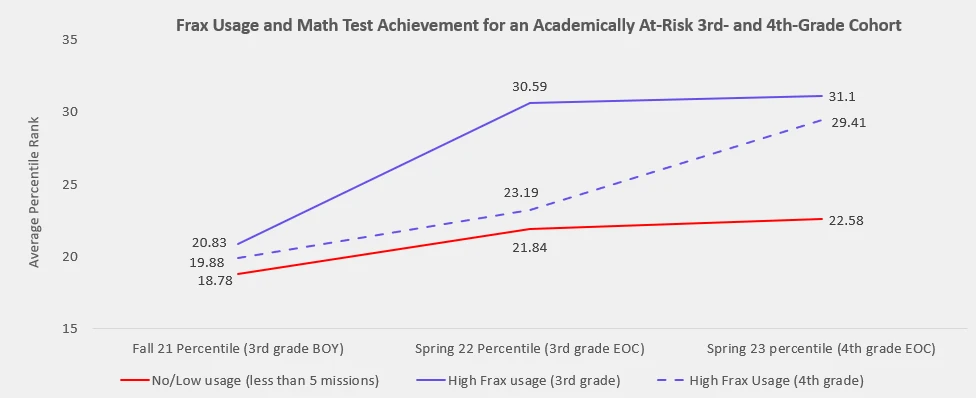
Students often struggle with understanding fractions, which is a strong indicator of future success in math. Learning and teaching fractions can feel complicated, but it doesn’t need to be that way. ExploreLearning Frax enables teachers to rethink fractions instruction.
Study at a glance
Our Research Team investigated whether Frax Sector I can be used as a math intervention to support proficiency in grade-level mathematics standards for students identified as “struggling learners” by 3rd-grade benchmark testing. Because Frax Sector 1 is designed as a zero-entry program, students with no previous knowledge of fractions can begin using it immediately.
Working with 462 3rd-grade students from a large suburban US school district (43% Hispanic/Latino, 13% Black/African American, 36% White, 78% economically disadvantaged), researchers evaluated the differences in student performance from Fall 2021 to Spring 2023 based on program use for the general student population and for students who were initially labeled as academically at-risk.
All about the research methodology
The details behind the efficacy research are as important as the results. For this study, researchers noted the following considerations:
- A retrospective analysis was conducted on students who scored two grade levels below their peers on a 3rd-grade baseline beginning-of-the-year (BOY) math assessment.
- Students either had no Frax usage, high Frax usage in 3rd grade, or high Frax usage in 4th grade.
- The outcome measured was each student’s percentile rank on their End of Course (EOC) math assessment.
Key Finding: Learners who struggle in math and used Frax showed significant math improvement over non-users
Students who had high Frax usage in 3rd grade improved on average by 10 percentile points compared to average growth in the no-usage groups. These students were also significantly more likely to move toward grade-level proficiency. Learners who struggled in math and used Frax were three times more likely to approach on-grade level proficiency by the end of third grade than similar non-Frax users.
Key Finding: At-risk students who used Frax were 2x more likely to achieve on-grade level status on 4th-grade EOC tests
A new group of students started Frax in Year 2. By the end of that assessment period, both groups of Frax users showed similar student achievement and significantly outperformed non-Frax users. Learners who struggled in math and used Frax were two times more likely to reach on-grade level proficiency by the end of 4th grade compared to similar non-Frax users.

Older students also benefit from Sector 1
In Sector 1, students develop a foundational understanding that fractions are numbers that can be compared and represented on a number line, which research shows many students still struggle to grasp well into later grades.. Every lesson helps students at all levels with a focus on developing number sense with fractions through scaffolded tasks and interactive representations. At-risk students with no Frax usage remained at-risk, only experiencing slight improvement from Fall 2021 to Spring 2023. However, older students who used Frax demonstrated learning gains
Whether Frax was used in 3rd or 4th grade, students showed significant and sustained improvements in math achievement compared to peers who did not use Frax. Get all of the details in the study.
Frax solves a fundamental problem, unblocking the path to student confidence and success with fractions. Isn’t it time to try a research-based math program with your students? Take a free trial.
